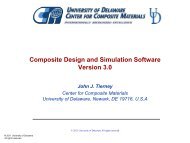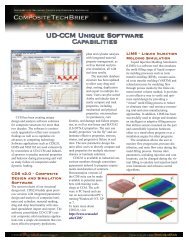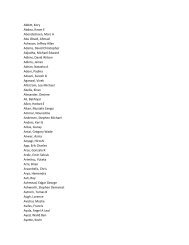Dynamic properties of shear thickening colloidal suspensions
Dynamic properties of shear thickening colloidal suspensions
Dynamic properties of shear thickening colloidal suspensions
You also want an ePaper? Increase the reach of your titles
YUMPU automatically turns print PDFs into web optimized ePapers that Google loves.
202<br />
sRMS d ¼<br />
ffiffiffiffiffiffiffiffiffiffiffiffiffiffiffiffiffiffiffiffiffiffiffiffi<br />
R<br />
x 2p=x<br />
2p 0 s2 ddt q<br />
¼ sdffiffi p 1:11sd, could be used<br />
2<br />
with equal superposition to within the accuracy <strong>of</strong> our<br />
measurements. However, the data do not superimpose<br />
when plotted against the maximum applied stress, or the<br />
<strong>shear</strong> rate. At the point <strong>of</strong> <strong>shear</strong> <strong>thickening</strong>, the dynamic<br />
viscosity is found to be comparable to the steady <strong>shear</strong><br />
viscosity measured at the same average stress. Deviations<br />
between the complex and steady <strong>shear</strong> viscosities<br />
are evident at both low and high <strong>shear</strong> stresses, as will be<br />
discussed below.<br />
Using the model developed by Maranzano and<br />
Wagner (2001a, 2001b), the critical <strong>shear</strong> stress for <strong>shear</strong><br />
<strong>thickening</strong> (sc) can be predicted from independent<br />
measurements <strong>of</strong> the particle size, concentration, surface<br />
potential, and ionic strength. The equation for the critical<br />
<strong>shear</strong> stress for electrostatically stabilized dispersions<br />
is<br />
sc ¼ 0:024 kBT ðjaÞW 2<br />
ð2Þ<br />
a 2 lb<br />
where l b is the Bjerrum length defined by l b ” e 2 /<br />
(4p 0k BT), a is the radios <strong>of</strong> the particle, and Y s=w se/<br />
k BT is the dimensionless surface potential. The theoretical<br />
predictions for s c are found to be in good agreement<br />
with the measured values (Table 1). In this table h m is<br />
the characteristic separation distance in the incipient<br />
hydrocluster state, which is determined directly from<br />
j )1 , the Debye length by h m=1.453/j.<br />
The extended Cox-Merz rule equates the steady and<br />
dynamic viscosities at equivalent <strong>shear</strong> rate and frequency.<br />
As our data is highly nonlinear, this relationship<br />
is observed not to hold. For materials with slow relaxing<br />
microstructure, a modified Cox-Merx rule has been<br />
proposed by Doraiswamy et al. (1991) known also as the<br />
‘‘Delaware-Rutgers’’ rule. The basis <strong>of</strong> this approach is<br />
that slowly relaxing materials respond to the highest<br />
applied strain rate applied during the dynamic measurement.<br />
Consequently dynamic and steady <strong>properties</strong><br />
overlay when the highest <strong>shear</strong> rate experienced during<br />
the oscillation is taken as the effective steady <strong>shear</strong> rate<br />
ðc 0x _c). Raghavan and Khan (1997) use this rule to<br />
correlate the steady <strong>shear</strong> <strong>thickening</strong> to strain <strong>thickening</strong><br />
for their fumed silica suspension. In Fig. 3 we compare<br />
data obtained from a frequency sweep experiment with<br />
imposed maximum stress <strong>of</strong> 10 Pa to steady <strong>shear</strong> data<br />
in the sprit <strong>of</strong> the ‘‘Delaware-Rutgers’’ rule. It is<br />
apparent that the ‘‘Delaware-Rutgers’’ rule applies in<br />
Table 1 Comparison <strong>of</strong> experimental and theoretical critical <strong>shear</strong><br />
stress foraqueous silica particle <strong>suspensions</strong><br />
Volume<br />
fraction /<br />
ja hm<br />
(nm)<br />
Theoretical critical<br />
<strong>shear</strong> stress sc (Pa)<br />
0.55 8.4 39 37 20±0.5<br />
0.60 9.4 35 41 46±0.5<br />
Experimental critical<br />
<strong>shear</strong> stress sc (Pa)<br />
the region <strong>of</strong> <strong>shear</strong> thinning for the suspension <strong>of</strong> 60%<br />
silica particle, but that the <strong>shear</strong> <strong>thickening</strong> transitions<br />
do not superimpose. Closer inspection <strong>of</strong> the data <strong>of</strong><br />
Raghavan and Khan (Fig. 10 <strong>of</strong> their work) shows a<br />
similar level <strong>of</strong> disagreement upon <strong>shear</strong> <strong>thickening</strong>.<br />
Consequently neither extended Cox-Merz nor the Delaware-Rutgers<br />
rule correlates dynamic and steady viscosities<br />
in the <strong>shear</strong> <strong>thickening</strong> regime. This is further<br />
confirmed by Mewis and Biebaut (2001), who report<br />
qualitative differences in the parallel superposition viscoelastic<br />
measurements between <strong>shear</strong> thinning and<br />
<strong>shear</strong> <strong>thickening</strong> parts <strong>of</strong> the flow curve. Thus, although<br />
the ‘‘Delaware-Rutgers’’ rule applies to the <strong>shear</strong> and<br />
frequency thinning regions <strong>of</strong> the flow curve, it fails to<br />
correlate the viscosity in the <strong>shear</strong> thickened state or the<br />
onset <strong>of</strong> the <strong>shear</strong> <strong>thickening</strong> transition.<br />
This result is consistent with the concept that the<br />
<strong>shear</strong> <strong>thickening</strong> transition is stress controlled, as demonstrated<br />
in Fig. 2 above. As the <strong>shear</strong>-<strong>thickening</strong><br />
transition is relatively fast for our materials, and the<br />
response is in the nonlinear regime, neither the extended<br />
Cox-Merz rule nor the Delaware-Rutgers approach<br />
would be expected to hold in the <strong>shear</strong> <strong>thickening</strong><br />
regime, as demonstrated.<br />
Shown in Fig. 4 is the <strong>shear</strong> <strong>thickening</strong> behavior as a<br />
function <strong>of</strong> strain amplitude for the aqueous suspension<br />
at 60 vol.% silica. The strain reported here is the measured,<br />
peak strain amplitude (this experiment is<br />
Fig. 3 Application <strong>of</strong> Cox-Merz and Delaware-Rutgers rules for<br />
60 vol.% aqueous silica dispersion






